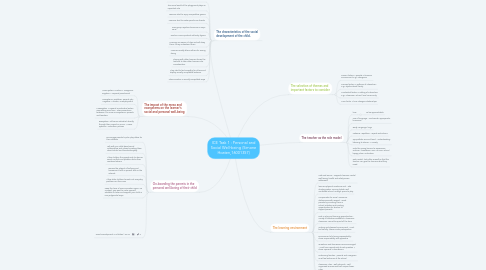ICE Task 1 : Personal and Social Well-being (Simone Hoaten,16001357)
by Simone Hoaten


1. The impact of the meso and exosystems on the learner’s social and personal well-being
1.1. Meso system= Postive = caregivers, negative = corporal punishment
1.2. Exosystem= postitive= parents job , negative = media+ unemployment
1.3. Mesosystem = expand as individual enters new setting over time , interconnections between 2 or more microsystems= parents and teachers
1.4. Exosystem= influence individual directly through their impact on micro + meso systems = education policies
2. The characteristics of the social development of the child.
2.1. Learner is starting to become more independent - Teachers and friends become more important than caretakers, but child still needs the adults to meet their basic needs
2.2. The social world of the playground plays an important role
2.3. Learners start to enjoy competitive games
2.4. Learners start to make specific sex friends
2.5. Peer-group rejection becomes a major issue
2.6. Teacher's are important authority figures
2.7. Learners are aware of rules and will obey them if they understand them
2.8. Learners readily blame others for wrong doing
2.9. Playing with other learners forces the learners to take other learners into consideration.
2.10. They start to feel empathy for others and display socially acceptable behavior
2.11. Show emotion in socially acceptable ways
3. On-boarding the parents in the personal well-being of their child
3.1. Encourage parents to plan play dates for their children
3.2. Talk with you child about social relationships and values by asking them about school and friends everyday
3.3. Allow children the opportunity to discuss social conflicts and problem-solve their reactions/actions
3.4. Discuss the subject of bullying and harassment, both in person and on the Internet.
3.5. Allow older children to work out everyday problems on their own
3.6. Keep the lines of communication open—as a parent, you want to make yourself available to listen and support your child in non-judgmental ways
3.7. Social Development in Children | SCAN
4. The selection of themes and important factors to consider
4.1. Person factors = people in learners environment, e.g= caregivers
4.2. Process factors = patterns of interaction, e.g= dysfunctional family
4.3. Contextual factors = setting of interaction, e.g= classroom, school, local community
4.4. Time factor = time changes relationships
5. The teacher as the role model
5.1. love
5.1.1. To be approachable

